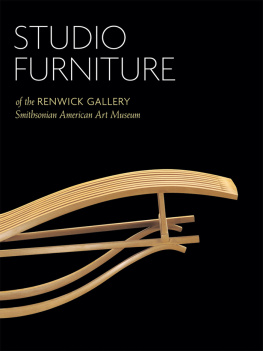Contents
Guide
STUDIO
FURNITURE

Contents

Stephen Courtney, Secretarial Desk (detail); see .
Foreword
FURNITURE IS THE MOST OVERTLY FUNCTIONAL AND physical of all the arts. It keeps our bodies off the ground; it supports our repose; it provides our work surfaces; it stores and protects the stuff we eat and wear; and it protects and contains those precious things with which we choose to surround ourselves. It is core to our material existence.
But it is so much more. Furniture always has been a principal vehicle of human expression, from the earliest examples that have survived through the millennia up to the present. It has been a cultural signifier of prime importance, giving us indications as to the nature of the lives of those who made and used it. To look at ancient Egyptian or Chinese, eighteenth-century English, or nineteenth-century American Shaker furniture is to be presented with an essay on the social and spiritual mores of those peoples. It is an indicator of civilization.
Furniture is perhaps more allied to architecture than any of the other individual craft-based arts. It renders architecture useful in its normative functions, and it humanizes it. Some of the greatest furniture was designed by architects. Indeed, the reverse also is true. Robert Adam and Gerrit Rietveld, for example, provided the eighteenth and twentieth centuries respectively with seminal furnishings and buildings.
Apart from the heritage tying it to architecture, furniture has always been, and is, a freestanding art. And as such, it would in some senses be fair to say that as an art, it lost ground in the twentieth century. The loss was at least in part due to one of the most dominant philosophical positions on the production of modernist furniture, which insisted on focusing not on furniture as art, as a vehicle for individual and cultural expression, but on furniture as purely mechanical, as equipment for use in the domestic and work environments. Indeed, the whole world of ornamentation and decorationas artcame under challenge in this period, and as such, furniture came under pressure to simplify its role in our culture.
It is in this regard that the role of the modern crafts has been vital. From the later nineteenth century, generation after generation of modern craftspeople struggled, against the functionalist trend, to maintain the possibility that furniture could be a medium for individual expression, as well as the conduit through which the history of furniture, and the people who created it, could be continually revisited. From the arts and crafts movement and the masters of art nouveau and the secession, through to the masters of the studio crafts movements of the later twentieth century, furniture has continued to serve as a medium for intellectual and emotional expression and as a vehicle for cultural memory.
I would say that after phenomenal development through the first half of the twentieth century, by 1970, America had become a dominant nation across much of craft practice. American ceramics and glass artists, for example, were absolutely core to the efflorescence of those practices into a sculptural, expressive, and dramatic new tradition. American jewelers took full part in the dramatic evolution that saw jewelry become a conceptually driven discourse. And fiber artists pushed textile art into wholly new realms.
The furniture world was, on the whole, less cohesive and dramatic than these other genres and unfolded in a more subtle and complex way. It never had a movement. There is no one cohesive school or intellectual thrust in American furniture making, but rather, a number of seams of activity. Some makers remained broadly loyal to what might be termed the arts-and-crafts tradition, at its most powerful in the later nineteenth and early twentieth century; others effectively combined wood carving with furniture to forge a more sculptural practice; some used popular and folk imagery to make witty and cryptic comments on life; some blended in with mainstream design; and yet others developed conceptual approaches that questioned the very nature of furniture itself. It has been a rich diversity, and one that can be collectively assessed only with rigorous and patient scholarship. That is where this book comes in.
The Renwick Gallerys studio furniture collection is a vital resource for the study and appreciation of American furniture. The eighty-four examples catalogued here constitute one of the most important American collections. Like all museum collections, and of course museums themselves, there is often little in the way of logic in the initial founding impetus. Vacated by the U.S. Court of Claims, the historic building that is now the Renwick Gallery lay vacant until First Lady Jacqueline Kennedy advocated a viable program and purpose for it. The government then transferred the building to the Smithsonian Institution.
When the Renwick Gallery was formed in 1972, it had no mandate to build a collection. Beginning in the mid-1980s, under the leadership of National Museum of American Art Director Charles Eldredge, the Renwick formed a policy to collect. From then on, it did so with intelligence and gusto.
Studio Furniture is a seminal contribution to furniture literature. It seems to me that above all else it does three things. First, it is an absolutely vital resource for the history of modern American furniture makers. The biographies and bibliographies of these central makers provide the student, collector, and educated layperson with the foundation for study. Second, taken as a whole, the volume is a concise history of modern American furniture practice. Third, the catalogue is a brilliant institutional history of American craft.
Modern American furniture makers have been open and experimental with regard to diverse materials. Many practice with metal, fiber, plastic, and found materials. Nevertheless, at the core of the furniture genre is wood. And in the twentieth century, that has been the single greatest contribution of the American masters. In a nation blessed with extraordinary supplies of the raw material and migrs from rich furniture-making countries, the environment for a continuing tradition of expressive wooden furniture was always here. Accordingly, as these pages reveal, the tradition of wooden furniture has been maintained and pushed into wholly new terrain. The range is remarkablefrom the raw expressiveness of Garry Knox Bennett to the breathtaking exactitude of Wendell Castle; from the virtuosity of John Cederquist to the eclectic, adjusted traditionalism of Daniel Mack; from the classic seriousness of Wharton Esherick to the subversiveness of Jacob Cress.
Perhaps this returns me to my earlier point. Furniture is simultaneously the most functional and physical of craft media, but it is also redolent with conceptual, historiographic, and individual narrative. Perhaps more than any other group internationally during the last fifty years, the American artists chronicled in Studio Furniture have reminded us such narratives always have been part of the furniture universe. We owe them much.
Paul Greenhalgh
Director, The Corcoran Gallery of Art Washington, D.C.
Acknowledgments
THE AUTHORS NAME APPEARS ON THE TITLE PAGE, but no book is possible without the help of countless friends and colleagues who contribute in both small and large ways to make it a reality. First and foremost is Charlene Johnson, who completed the daunting task of compiling the bibliography and biographical sketches that bring to life each of the artists represented in the Renwick collection. As a student, collector, scholar, and studio artist in her own right, Johnson has been a constant advisor, reader, and friend without whom this project might never have been completed.








